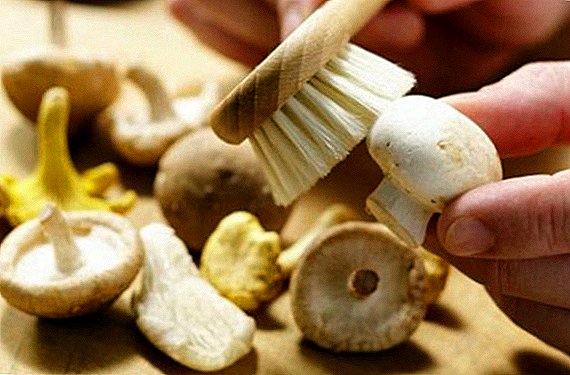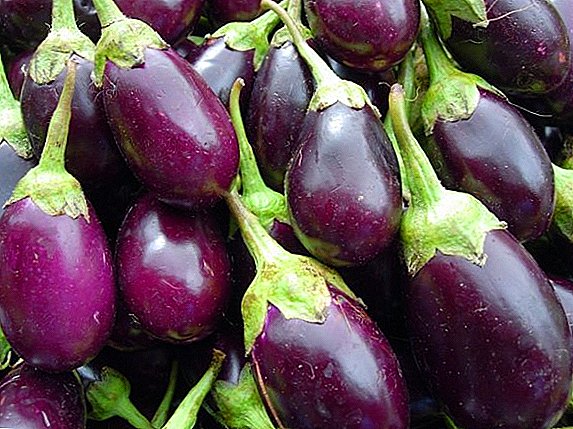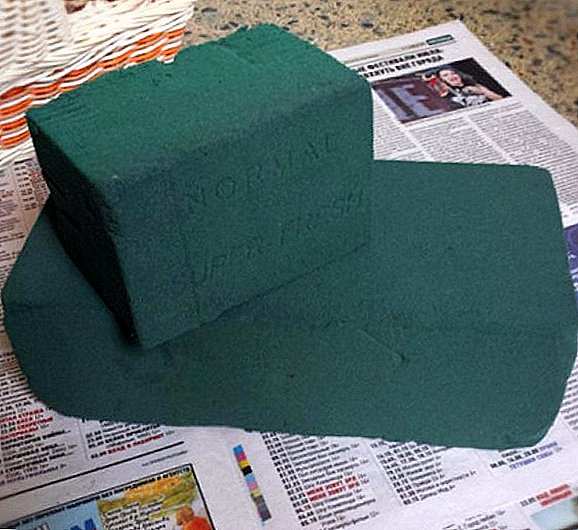 Flowers are that without which almost no holiday can do. They are also often used for home furnishings. Magnificent compositions of various forms and shades can be made thanks to special devices, one of which is floral sponge.
Flowers are that without which almost no holiday can do. They are also often used for home furnishings. Magnificent compositions of various forms and shades can be made thanks to special devices, one of which is floral sponge.
Floristic foam for flowers
Floristic foam (flower sponge, oasis for flowers, piaflor) is a special floristic device made of artificial substance with small pores. It perfectly absorbs water and remains wet for quite a long time.  For the first time this sponge appeared in Denmark in the 40s. XX century., And since then the secret of its manufacture keeps "behind seven locks".
For the first time this sponge appeared in Denmark in the 40s. XX century., And since then the secret of its manufacture keeps "behind seven locks".
Did you know? The invention of the oasis for flowers was not specifically planned, instead a substance was developed for aircraft construction.
This foam is designed for mounting flowers in the compositions, as well as to extend their life.
Types and features
Today, manufacturing companies produce many different types and forms of piaflora, depending on their specific purpose.
For fresh flowers
For live bouquets, an oasis of green is produced. Most often, it is sold in the form of a rectangular block, on which 2 cutting lines are marked. You can also find the shape of an oval or cube.
Oasis is cut fairly easily, so if necessary, you can cut out any shape from it. If you do not want to do this, you can search the stores for a ready-made shape of balls, hearts, wreaths, carriages, steam trains, animals, hemispheres, numbers, machines, globes, etc. True, they are rarely on sale and are more expensive than ordinary ones.  Some forms are sold already attached to the base, so these compositions can be hung or immediately put on the table.
Some forms are sold already attached to the base, so these compositions can be hung or immediately put on the table.
Find out how to keep cut peonies, tulips, roses and lilac for a long time at home.
Piaflor allows you to keep a fresh look of flowers longer, as well as to give free rein to your imagination, because the flowers will stay in the composition, no matter what angle you put them there.
Absorbing a large amount of water, the oasis becomes heavy up to 30 times, so the flowers do not fade for a long time. In addition, the sponge is impregnated with a special solution that prevents bacteria from multiplying.
For cut flowers
In order for the flower arrangement to keep its shape well, it must be taken into account that different types of floristic foam are provided for different colors:
- Ideal (Ideal) - suitable for any kind, as it has a moderate density.
- Classic (Classic) - this option should be chosen if the composition is from specimens with bending stems.
- Standard (Standart) - suitable for those who make the composition of flowers with thin shoots, as well as for small home bouquets.
- Premium (Premium) - this foam has improved characteristics, its density and elasticity are much higher, it is better to use it for plants with massive inflexible shoots.
- Instant (Instant) - suitable for any plant, its distinguishing feature is an accelerated rate of soaking.
 All these sponges are green. Multicolored oases (Rainbow) are also produced, which are well established for compositions from both living and artificial flowers. Bright colors allow you to use these sponges as part of the composition and not to hide them.
All these sponges are green. Multicolored oases (Rainbow) are also produced, which are well established for compositions from both living and artificial flowers. Bright colors allow you to use these sponges as part of the composition and not to hide them.Important! Regardless of the type of sponge, it is better not to use it for bouquets with tulips and daffodils, as they do not absorb water from it.
For artificial
If you make bouquets of dried plants or artificial flowers, a special floral foam Oasis Sec. It is available in gray or brown, but if you wish, you can repaint it with an ordinary spray. No need to soak.
When working with such an oasis, care must be taken, as it finely crumbles and can be transferred to the foam for fresh flowers, worsening its water permeability. In addition, some florists use the same sponge for living flowers to create lifeless bouquets, but not soaking it.
Instructions for use
Before use, read the instructions for use of the sponge, because of the correctness of its operation depends on the fresh look and beauty of the bouquet:
- Cut a piece of the required size from the foam (you can cope with a clerical or construction knife, and some recommend doing it with the foam already soaked to avoid inhaling the dust).
- Take a clean deep bowl and pour water into it. The depth of the bowl should be at least twice the height of the sponge.
- Dip the cut off part on the water and leave it in this position for about 1 minute.
- Wait until the sponge sinks to the bottom.
- Take it out, place it in a vase, basket or other container and use it to decorate bouquets.
- Cut the lower leaves and spines of flowers so that they do not fall into the foam and do not start to rot, cut off the tip of the shoot at a sharp angle by 2 cm.
- If a basket or other container through which water can leak is used to create a flower arrangement, wrap the sponge underneath with a thick polyethylene, securing it with tape.
- If necessary, attach the oasis to the base, use a special tattoo with spikes called "frog", sticky mass oasis-fix (or ordinary clay, adhesive tape.
- If you are planning a round bouquet, piaflor must be placed much higher than the edge of the container in which it will be located, and if the future colors are on the same level, it will be placed slightly below the edge.
- Every day, water a sponge with a small amount of water, evenly distributing it over the surface and preventing it from drying out.
It is advisable to pre-plan the composition and consider where and what flowers will be located so that the extra holes do not violate the density of the foam.
Important! Do not immerse the sponge in the water with your hands or put it in a dry bowl and pour water on top - this will lead to the formation of stains that the water has not reached.
It is recommended to additionally fix large flowers with a special net or wire, as the sponge may not hold them.
When you cut the sponge, remember that in the capacity for the bouquet, it should pass freely. Pressing and pushing will cause it to compress and close the pores.
Is it possible to return the "life" foam for flowers
Analyzing the floral composition, pay attention to the condition of the floral sponge, perhaps it can be used again.
Feel the foam - the presence of moisture indicates good condition. In this case, the sponge must be carefully wrapped in polyethylene, limiting the access of air, so as not to dry out.
However, do not despair if the sponge is dry to the touch, it can be restored. To do this, you need to boil the water, drip into it with liquid soap and pour the foam over this solution. But keep in mind that by moisture-absorbing properties, it will already give way to a new sponge. 
How to replace the floral sponge
Before the invention of piaflora, florists used sand wrapped in cellophane, wetted soil and moss. Now it is difficult to imagine something more comfortable than a floral sponge. Other materials will not be able to provide such access of flowers to moisture and their reliable fastening.
Did you know? In the sixteenth century. for 1 onion tulip was given 2 thousand dollars, translated into current money.
For bouquets of artificial flowers, you can use ordinary foam or building foam, and to keep the flowers better, put a little glue in the hole.
Floristic sponge for artificial flowers: how to make a bouquet
Floral oasis can also be used for the manufacture of artificial flowers, see the process in more detail.
What is needed
To make a bouquet, prepare:
- portbuketnitsa - a special plastic device-tube for a bouquet (in a simple way - a microphone);
- floristic foam, better than brown (for artificial flowers);
- thick wire;
- pliers;
- cutting pliers;
- artificial buds (bulk and flat);
- thin foam and a piece of cloth (for flat buds);
- needle and thread;
- glue gun (if available).

Forming a bouquet you need to remember that many flowers are not combined with each other. Very beautiful bouquets are obtained from lilies. They can be diluted: peonies, phlox, irises, primula.
Step-by-step instruction
To make a bouquet, follow this sequence:
- Cut with a wire cutter a piece of wire of the desired length.
- Using pliers, bend the tip of the wire so that it looks like a fishing hook.
- This hook must be put in the middle of the flower bud.
- Check whether he caught there well.
- Repeat the procedure for other buds that will be in the center of the bouquet.
- Prepare the wire for the buds, which will be located at the edges: cut, bend the wire with a hook, and then make a small smooth bend a little lower, as if you were going to twist the letter "O", but changed your mind.
- Put the bud on the hook without closing the bend.
- Check for wire removal.
- Repeat the procedure for all the buds that will be on the edge of the bouquet.
- For flat buds, it is necessary to retreat a little more distance from the edge of the wire than for bulk buds, and bend it with a hook.
- Cut out polystyrene circles with a diameter of 2 times smaller than the bud.
- Mugs of this size should be cut from the fabric so that the foam is completely closed on both sides and a small tail is left.
- Use a long end to stick the wire into the foam, push it to the end and set it on the hook. It will be like a button.
- Bend the short end of the wire to the bottom so that the foam holds well.
- Place a cloth circle on top of the foam, cover it and carefully tail the tail around the wire.
- From a glue gun drop a little glue on the fabric and glue the bud or just sew it with thread.
- If you bought a portbookette without an oasis, then you need to cut a circle of a sponge of the appropriate size and insert it.
- Put big buds into the center in the portbook, then arrange the small ones. The bouquet is ready.
Important! Cut the wire into pieces a little longer than the planned height of the flowers, it is better to trim them later.
Sponge for flowers: the pros and cons
When purchasing a floristic oasis, you must take into account the positive and negative aspects associated with its use.
What are the advantages
The positive side of using foam is as follows:
- convenient to use;
- keeps the bouquet form;
- does not rot to flowers;
- allows you to cut out any shape from it;
- different affordable cost.
Main disadvantages
However, with all its advantages, the oasis has its weak points:
- not suitable for all colors (for example, daffodils and tulips will not be able to live in it);
- holes from wrong punctures do not tighten;
- dries without watering;
- crumbles when chopped, can cause allergies;
- big flowers need to be stapled in addition;
- when reused loses most of its properties.
 So, the floral oasis allows you to translate into reality a variety of bouquets of fantasy. You can not worry about the fact that the bouquet will lose its appearance or begin to decay.
So, the floral oasis allows you to translate into reality a variety of bouquets of fantasy. You can not worry about the fact that the bouquet will lose its appearance or begin to decay.We recommend that you read about dried flowers for the winter bouquet.
However, truly durable and beautiful compositions are obtained only when used properly.












